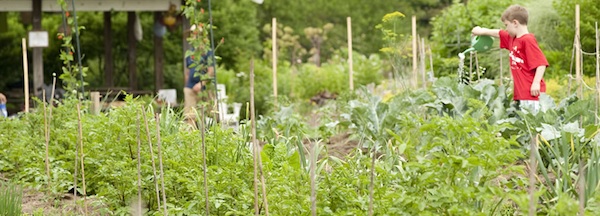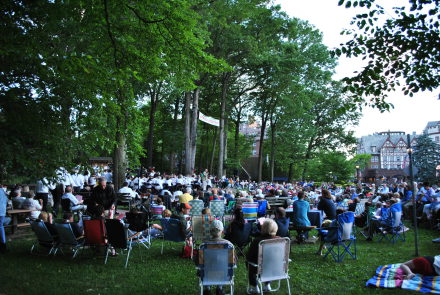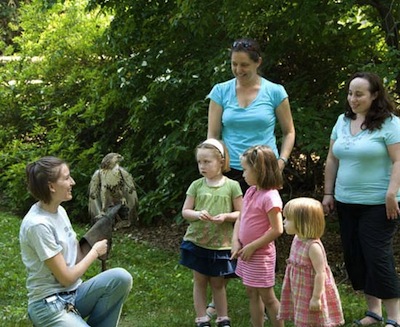Guide to Summer Fun for Scarsdale Kids
- Details
- Written by: Jamie Kayam and Elizabeth Jacobs
- Hits: 18539
 Summer has finally arrived, which means you now have more time to spend with your son or daughter. You don't have to go far to share fun experiences with your kids. There are lots of places to bring your kids to keep them busy and happy. Here are a few of our favorites within a reasonable distance from Scarsdale:
Summer has finally arrived, which means you now have more time to spend with your son or daughter. You don't have to go far to share fun experiences with your kids. There are lots of places to bring your kids to keep them busy and happy. Here are a few of our favorites within a reasonable distance from Scarsdale:

The best part: you can go back. Bounce U often has open-play schedules to fill in the gaps between reserved parties. For $10 or so you can send your toddler back into the inflated world they will learn to love.
Important tip: bring socks, they're required.
150 Clearbrook Rd
Elmsford, NY 10523
(914) 874-5200
Visit the website
Bruce Chung’s Tae Kwon Do: Grandmaster Bruce and Master Susan Chung have been teaching Tae Kwon Do for 21 years. Children have loads of fun in their supercharged classes designed to build strength, stamina, coordination, and flexibility. Parents are thrilled to see their children gain confidence, self-esteem, and focus. Register now for their awesome 3-hour Summer Mini Day Camp for 3-8 year olds (groups separated by age) with flexible daily or weekly sign up. Their Gym-Mini Kick-it Program offers Mommy and Me classes for 1-3 year olds and Open Gym for 1 to 5 year olds. They also offer Adult Tae Kwon Do and Fitness Programs. Call anytime for a free trial class or to sign up for Summer or Fall!
250 Halstead Avenue
Harrison, NY 10528
914-835-0665
Visit the website
Chelsea Piers Connecticut is a busy destination for summer fun rain or shine. Kids of all ages enjoy summer sports camps, sports-themed birthday parties and super-fun drop-in programs, including trampolines, rock climbing and the Splash Zone water park. Visit their website www.chelseapiersct.com for more information or call 203.989.1000. Chelsea Piers Connecticut is conveniently located in Stamford, right off I-95, Exit 9.
1 Blachley Road
Stamford, CT 06902
(203) 989-1000
Visit their website
Elmsford Raceway: This raceway is essentially a Nascar event without the excessive noises and smells — instead, miniature cars run on electric tracks that zip around in figure eights, again, and again and again. Kids propel their cars with hand-held controllers and quickly learn that speeding will send their rides off the tracks. Toddlers may not entirely grasp the concept of not going full-throttle into every turn, but they will experience the thrill of the race.
Bring a cake, have a party. Rita's Ice Custard Happiness is next door.
344 Saw Mill River Rd,
Elmsford, NY 10523
(914) 592-5375
Visit the website
 Free Band Concerts in Chase Park: The Westchester Band holds free outdoor concerts every upcoming Thursday in July. Listeners will hear music ranging from pop to opera, as well as vocal and instrumental soloists. These events take place Chase Park.
Free Band Concerts in Chase Park: The Westchester Band holds free outdoor concerts every upcoming Thursday in July. Listeners will hear music ranging from pop to opera, as well as vocal and instrumental soloists. These events take place Chase Park.
Great Play of Scarsdale: The Great Play of Scarsdale host's daily camps for children ages 3-6 and 4-8. The summer camp for ages 3-6 takes place every Monday from 1:00-1:30pm and every Tuesday, Wednesday, and Thursday from 10:00-12:30pm. The summer camp for ages 4-8 is held every Tuesday and Wednesday from 1:00-3:30pm. Your child can participate every camp day, or selected camp days. This program promotes youth physical development. The children spend their time playing games and learning motor and sports skills.
969B Central Park Ave
Scarsdale, NY 10583
(914) 713-3470
Visit the website
 Greenburgh Nature Center: You'll be enchanted by the short walk to the main building as you encounter a well-kept Tudor that's home to a green house, reception rooms and an indoor petting zoo for small creatures. It's a wonderful place to host a child's birthday party, as the rooms are large and well lit, and they'll bring a bit of the petting zoo to you.
Greenburgh Nature Center: You'll be enchanted by the short walk to the main building as you encounter a well-kept Tudor that's home to a green house, reception rooms and an indoor petting zoo for small creatures. It's a wonderful place to host a child's birthday party, as the rooms are large and well lit, and they'll bring a bit of the petting zoo to you.
Outside are some additional animals and grounds to explore, and then there's the playground, beautiful, spacious and unique. Your kids won't want to leave.
99 Dromore Rd
Greenville NY 10583
(914) 723-3470
Visit the websiteHocus Pocus Magic Shop: Hocus Pocus Magic Shop will open on Saturday, July 12th. Make sure to stop by this magical shop to learn about the power of magic and to see child-friendly magic shows.
7 Dunwoodie Street
Scarsdale, NY 10583
(914) 755-1450
Visit the website
 Katonah Museum of Art: If your child is feeling inquisitive, take them over to the Katonah Museum of Art. The museum offers activities and events that any youngster would surely enjoy.
Katonah Museum of Art: If your child is feeling inquisitive, take them over to the Katonah Museum of Art. The museum offers activities and events that any youngster would surely enjoy.
134 Jay Street - Route 22
Katonah, NY 10536
914-232-9555
Visit the website
Saturdays, 10:30 am
Saturday Story Time
Books are read to children by special guests, then they create artwork in the Learning Center.
July 8, 15, 22, 29, August 5 from 1:00 – 2:00pm
Tuesdays for Tots
Participate in outdoor painting, mini-environments, and nature sculptures with your son or daughter. For children ages 3-5. Pre-paid registration required.
Thursdays, July 10, 17, 24, 31, August 7, from 10:00am – 2:00pm
Summer Art Adventures
Crafts and art education inspired by museum exhibits. For children ages 6-12. Pre-paid registration required.
The Maritime Aquarium at Norwalk: As you walk in you'll encounter the stingray petting zoo! Don't be scared, they're friendly (and quite smooth). In general, this place has a lot of fish, so keep exploring. Other fun attractions are the IMAX theater and shark tank. Everywhere you go there's always something going on, and, since the whole place is geared towards kids, there's even a play center on the second floor so you can rest your weary legs while your kids carry on.
10 N Water St
Norwalk, CT 06854
(203) 852-0700
Visit the website
 The New York Botanical Garden: If you travel on Metro North Railroad, you've probably seen their ads — the best known is the Holiday Train Show during the winter. You'll see dozens of miniature trains commute on tracks thoughtfully arranged amongst wooden models of famous New York City landmarks.Our 2-year-old had such a good time, we took him back three times to see the trains and to enjoy a small theater production featuring Thomas the Tank Engine. One chilly afternoon as we were exploring the grounds, we were invited to take a Family Membership which the Garden discounts against the Train Show's ticket cost. Membership paid for itself after 2 visits. And there's much more. NYBG is a very big estate, so we'll be going back again soon. Wear good walking shoes and bring a stroller for the kids.
The New York Botanical Garden: If you travel on Metro North Railroad, you've probably seen their ads — the best known is the Holiday Train Show during the winter. You'll see dozens of miniature trains commute on tracks thoughtfully arranged amongst wooden models of famous New York City landmarks.Our 2-year-old had such a good time, we took him back three times to see the trains and to enjoy a small theater production featuring Thomas the Tank Engine. One chilly afternoon as we were exploring the grounds, we were invited to take a Family Membership which the Garden discounts against the Train Show's ticket cost. Membership paid for itself after 2 visits. And there's much more. NYBG is a very big estate, so we'll be going back again soon. Wear good walking shoes and bring a stroller for the kids.
2900 Southern Blvd
Bronx, NY 10458
(718) 817-8700
Visit the website
Parties in the Park: The Scarsdale Recreation Department hosts gatherings of music and entertainment for children of all ages and their parents. These events take place on Friday, July 18th from 6-8pm at Chase Park and Friday, July 25th from 6-8pm at Aspen Park.
Rye Playland: Spend a few hours at Rye Playland for an afternoon of rides, snacks, and pure fun. Stop by KiddyLand with your child and participate in some of the daily events that are offered. More detail on the daily events 
Playland Parkway
Rye, NY 10580
(914) 813-7000
Visit the website
Scarsdale Public Library: The Scarsdale Public Library is packed with fun activities for your youngsters this summer. If you are looking for something to keep your child busy, don't miss out on these events.
54 Olmsted Rd
Scarsdale, NY 10583
(914) 722-1300
Visit the website
Wednesday, July 9th at 7pm
Science Quest Scavenger Hunt with Jason Edwards
Bring your child to this thrilling, but educational event that will help them learn something new while having a great time! This activity is for grades 1 and up and does not require registration.
Thursdays July 10th, 17th, 24th, and 31st at 4pm
Drop-In Crafts
There is never a bad time for arts and crafts! Your child will definitely enjoy this crafty activity. Stop by for any one of the events or all four of them! This activity is for ages 3-7. Registration is not required.
Fridays July 11th, 18th, and 25th at 9:30am
Baby Free Play for Pre-Walkers
If your child is not yet walking, don't miss out on this event! Registration is not required.
Saturday, July 12th at 10:30am
Pirate Party
Dress up your child in their best pirate outfit for a motherload of a good time! Head over to the library with your youngster and get ready to party! This activity is for ages 3 and up. Registration is required.
Monday, July 14th at 7pm
Spinning Straw Into Gold: Tales of Alchemy with LuAnn Adams
Enjoy a scientific night at the library that is sure to educate your child on the principles of science! They will be blown away by magic illusions! This activity is for grades K and up. Registration is not required.
Tuesday, July 15th at 10:30am
Parachute Playtime
Games and activities for parents and children between the ages of 2 and 4. Registration is required and will begin on June 30th.
Wednesday, July 16th at 6:30pm
Circus Safari with Safari Bob
Your kids will learn about and be able to ride on robotic animals like Jake the Tiger and Tiny the Elephant. This activity is for ages 3 and up. Registration is not required.
Saturday, July 19th at 10:30am
Miss Gigi
Join Miss Gigi for a morning of fun activities. This activity is for children ages 2-5. Registration is not required.
Monday, July 21st at 7pm
Close Encounters with Birds of Prey
Your child will be able to observe and learn about raptors from the Delaware Valley Raptor Center including a Golden Eagle, a Peregrine Falcon, and a Saw-Whet Owl. This activity is for all ages. Registration is not required.
Tuesday, July 22nd at 10:30am
Toddler Drive-In Theatre
Bring your toddler to this event to craft a "car" and watch a short film. This activity is for ages 1 ½ - 3 ½. Registration is not required.
Wednesday, July 23rd at 10:00am
Petite Concert with Chi-Chi Bestman
A child-friendly concert and lesson on the violin and viola. For newborns and preschoolers. Registration is not required.
Wednesday, July 23rd at 7pm
Wolf Conservation Center of South Salem
Your child will be able to observe and learn about a real white wolf! For kindergarteners and older. Tickets are required and will be available on July 14th.
Monday, July 28th at 7pm
Princess Tea
Dress up your child in their favorite princess costume and head over to the library for some royal activities! For ages 3 and up. Registration is required and will begin on June 30th.
Tuesday, July 29th at 10:30am
Library Play Date
Bring your child in to play with toys all morning! For ages 2-5. Registration is not required.
Wednesday, July 30th at 7pm
Stick, Fizz, Hiss and BOOM with Animals from Green Meadows Farm
Let your child explore a farm... at the library! There will be cockroaches, chicks, lizards, bunnies, and more. For all ages. Registration is not required.
Westchester Broadway Theatre: There will be showings of the play Mary Poppins throughout the month at the Westchester Broadway Theatre. If your child enjoys theatre, this is the perfect event to bring them to. July Calendar
1 Broadway Plaza
Elmsford, NY 10523
(914) 592-2222
Visit the website
Memorial Service for Three Teens Slain in Israel
- Details
- Written by: Joanne Wallenstein
- Hits: 4915
 A memorial service for the three Israeli teens who were murdered in Israel will be held on Tuesday night July 1 at 7 pm at Bet Am Shalom Synagogue in White Plains by the Synagogue Communities of White Plains
A memorial service for the three Israeli teens who were murdered in Israel will be held on Tuesday night July 1 at 7 pm at Bet Am Shalom Synagogue in White Plains by the Synagogue Communities of White Plains
The clergy of the five White Plains synagogues will honor the three slain teens, Eyal Yifrah, Gilad Sha'ar and Naftali Frenkel.
The community will gather to share this grief with the State and people of Israel.
The memorial service will be held on Tuesday July 1, at 7:00 P.M. at Bet Am Shalom Synagogue, at 295 Soundview Avenue in White Plains.
Legislation to Allow a District Health Reserve Fund Passes the State Assembly and Senate
- Details
- Written by: Joanne Wallenstein
- Hits: 7144
 New legislation that will allow the Scarsdale School District to maintain a separate reserve fund for its self-insured health insurance plan has passed both the New York State Assembly and the Senate. The bill was authored by NYS Assemblywoman Amy Paulin and will be sent to Governor Cuomo to be signed into law.
New legislation that will allow the Scarsdale School District to maintain a separate reserve fund for its self-insured health insurance plan has passed both the New York State Assembly and the Senate. The bill was authored by NYS Assemblywoman Amy Paulin and will be sent to Governor Cuomo to be signed into law.
A few years ago, the district's auditors had determined that the maintenance of the reserve fund was not in compliance with law. As a consequence the Board voted to drain the Health Care Reserve to all but a token amount in response to the auditors and a few residents who criticized the Board for maintaining the fund.
This bill makes clear that the District can keep its separate reserve fund which will enable it to mitigate the potential negative impact from large unforeseen health care claims. If the bill is signed into law, the district and its taxpayers will continue to obtain the significant stabilizing benefits of maintaining a reserve fund and be in a better position to manage yearly variations in claims against its self-funded health insurance program.
Commenting on the passage of the legislation, Assemblywoman Paulin said, "I know how important maintaining this reserve fund is to the district and its taxpayers. We know the reserve fund has resulted in the district saving millions of dollars since it was established. I'm pleased to have been able to help ensure its continued use."
Assistant Schools Superintendent Linda Purvis who worked with legislators on the new law said, "Our self-insured health care plan for employees has literally saved millions of dollars for taxpayers over the last 20 years. It would have been difficult to continue it without a rate stabilizing insurance reserve, so we are very happy at this outcome. But it's the taxpayers who should be happy, because it's their money. Many many thanks to Assemblywoman Paulin, who has been working on this doggedly for several years, and to Senator Stewart Cousins, who worked so hard to get it through the Senate. These two women are amazing legislators, and we are so lucky to have them representing the District.
Funding the reserve will be obviously difficult. We are basically starting at ground zero again. So we will await the Board's decision on if and how to fund it."
In 2013, Mitchell Gross, a critic of the health reserve fund, called it a "fictitious account" in violation of NYS law and charged the district with violating reserve policies which dictate that a district hold no more than 4% in reserve. He claimed the district had "failed to disclose these reserves" and called it a "material and serious violation" made by the district to "mislead and misrepresent the public to obtain a positive outcome on the budget." He conjectured that this "may constitute securities fraud" and "jeopardize the district's credit rating." He then asked for Dr. McGill's resignation, called for new auditors and asked the district to consider the consequences of a budget that is not in compliance with the law.
Though Scarsdale Schools Superintendent Dr. McGill did announce his retirement shortly afterwards, this new ruling vindicates the superintendent and the district and makes it clear that the reserve is to the benefit, not the detriment of Village taxpayers.
Pizza and Wine at Zachys Draws a Crowd at Zachys
- Details
- Written by: Joanne Wallenstein
- Hits: 4717
 Over 300 people turned out at Zachys on a steamy Tuesday night to sample wines from South America and eat freshly baked pizza from the Cookery's DoughNation Pizza Truck. The truck pulled up in front of the store on East Parkway and chefs worked over the wood stove to make delicious varieties of pizza which was devoured with wines from Bodegas Norton and Concha Y Toro. We loved the Pisco 100 Punch, a blend of the Peruvian spirit Pisco 100 with pineapple juice and ginger beer. A light sweet drink for a hot summer's eve.
Over 300 people turned out at Zachys on a steamy Tuesday night to sample wines from South America and eat freshly baked pizza from the Cookery's DoughNation Pizza Truck. The truck pulled up in front of the store on East Parkway and chefs worked over the wood stove to make delicious varieties of pizza which was devoured with wines from Bodegas Norton and Concha Y Toro. We loved the Pisco 100 Punch, a blend of the Peruvian spirit Pisco 100 with pineapple juice and ginger beer. A light sweet drink for a hot summer's eve.



Maroon and White Announces Spring Athletic Awards
- Details
- Written by: Joanne Wallenstein
- Hits: 3976
Maroon and White lauded senior spring athletes at their barbeque on Tuesday June 3rd. Many of the families who named the awards attended the ceremonies with multiple generations represented.
Here are the proud Scarsdale seniors who won the awards presented by Maroon and White Co-Presidents Kathy Coleman and John McCann:
















